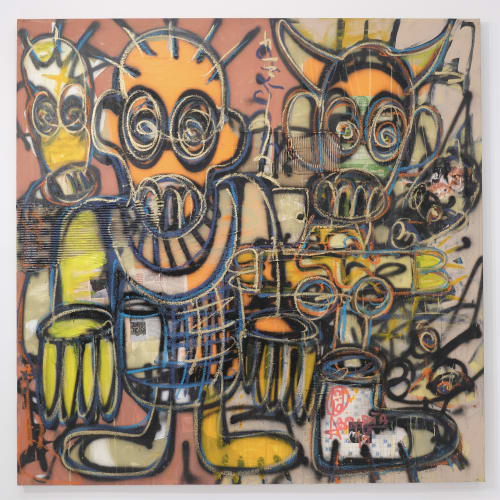Aboudia x Picasso x Paik x Tribal: New York, NY
Aboudia x Picasso x Paik
September 8 – October 14, 2023
Opening Reception: September 8, 5–8 pm
Ethan Cohen Gallery is pleased to present Aboudia x Picasso x Paik x Tribal, a thought-provoking exhibition that explores the profound dialogue between the works of Aboudia, Pablo Picasso, and Nam June Paik, and sheds light on the impact of traditional African art on each artist’s respective practice. This exhibition in many ways is both an acknowledgement and celebration of the artistic power and influence of African art and aesthetics.
Aboudia, a renowned Ivorian artist, is praised for his bold and emotionally charged paintings that reflect his personal experiences and observations of post-war life in his native country. He draws inspiration from street art and African tribal art, while also reflecting on the Second Ivorian Civil War and the effects of social inequality in his country. One of the side effects to the socioeconomic problems, which the people of the Ivory Coast endure to this day, is the growing number of children in Abidjan, the country’s capital, who live in the street. Aboudia calls attention to this important issue in his paintings, a life he himself survived. His dynamic and layered artworks convey a powerful narrative, exploring themes of conflict and resilience. By incorporating elements from the African artistic tradition in his approach to painting, Aboudia infuses his work with a deep sense of spirituality, symbolism, and a powerful connection to his cultural heritage, while also directing our attention to causes that need attention with his contemporary painting style he calls ‘nouchi’.
It is well documented that Pablo Picasso, one of the greatest pioneers of modern art, was deeply influenced by traditional African art, notably African sculptures and African masks. Although traditional African art had abstracted the human form from 23,000 BCE onwards, the western art world did not properly credit and recognize that achievement for centuries. Today, we can definitively say, traditional African art influenced some of modern art’s greatest cultural breakthroughs. On a visit to American writer and collector Gertrude Stein in the spring of 1907, Picasso developed a fascination with traditional African Art. He later acknowledged this visit and said, “I forced myself to stay, to examine these masks, all those objects that people had created with a sacred and magical purpose, to serve as intermediaries between them and the unknown and hostile forces that surrounded them, thereby trying to overcome their fears, giving them color and shape. And then I understood what painting really meant. It is not an aesthetic process, it is a form of magic that stands between us and the hostile universe, a means of taking power, imposing a form on our terrors as well as our wishes. The day I understood that, I found my way.” Later the same year, Picasso finished the famous painting 1907 titled Femme (Epoque des Demoiselles D’avignon), and abstracted the faces of his female subjects in ways similar to that of African tribal masks. Thus, Cubism was born. The abstract forms, simplified lines, and expressive qualities of African art resonated deeply with Picasso and aided him in discovering his own method of painting, leaving an indelible mark on his artistic vision. The significance of these spiritual artifacts and how they functioned in rituals and rites of passage shifted his understanding of what art can function as and represent. Picasso’s tenacious study of African tribal aesthetics and traditions proved essential to his profound contributions to Western art history.
Nam June Paik, a groundbreaking artist known for his innovative use of technology, also found inspiration in African art. Paik's multimedia installations, which seamlessly merge video and electronic elements with traditional art forms, reflect his exploration of the rhythmic patterns, ceremonial traditions, and communal aspects of African culture. This exhibition includes artworks in which Paik has embedded African masks and aesthetics into his two-dimensional works. Through his engagement with African art, Paik pushed the boundaries of contemporary art, forging new pathways of artistic expression.
The idea for this show blossomed after a stimulating visit by Ethan Cohen to the Fondation Beyeler in Basel to see a 2016 exhibition with the aforementioned Picasso painting that was eerily like Aboudia’s motifs. Cohen was moved and inspired by the convergent aesthetics of works 109 years apart evincing a visual link between Aboudia and Picasso. After an added introduction to rarely seen masterpieces by Nam June Paik, a visual conversation between the works of these three artists materialized.
The tribal works in the exhibition derive from Ethan Cohen’s private collection of outstanding African sculptures. They are selected as illustrative of the continuity between African and contemporary art, between Western and global art, all finding roots in the ancient aesthetic formulations of the African continent. Foremost among them, the incomparable 19th century beaded Yoruba royal crown from Nigeria; the carved wood Guerre mask with protuberant eyes from Liberia/Ivory Coast (a tangible inspiration both to Picasso and Aboudia); the red-dyed Igbo female fertility idol with direct sight-lines to Aboudia’s large ‘Cousteau Nudes’ painting (2016).
Aboudia x Picasso x Paik x Tribal celebrates the convergence of these three visionary artists while underscoring the enduring power of African art. By showcasing their respective artworks alongside the profound influence of African art, the exhibition highlights the universal and transformative qualities of artistic visions that transcend cultural and temporal boundaries.



